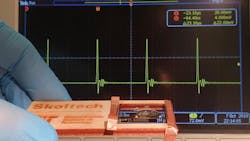Saturable absorbers for lasers can be controlled via electrochemistry
An international team of scientists led by researchers from the Laboratory of Nanomaterials at the Skoltech Center for Photonics and Quantum Materials (CPQM; Moscow, Russia) has shown that the nonlinear optical response of single-walled carbon nanotubes (SWCNTs) can be controlled by electrochemical gating, which has enabled designing a device for controlling laser pulse durations.1
Normally, the efficiency of nonlinear optical response is material's invariable characteristic determined by a material's structure; however, using nanomaterials as an optical nonlinear medium opens up new perspectives for nonlinearity control thanks to the fact that the majority of its atoms are exposed to the surface, enabling control of a material's electronic structure and thus a change in its nonlinear optical response.
Skoltech scientists, in collaboration with their colleagues from the Fiber Optics Research Center of the Russian Academy of Sciences (RAS), Novosibirsk State University, and the University of Warwick (UK) have devised a method for controlling the saturable absorption of SWCNTs using electrochemical gating via low-voltage (less than 2 V) control. Saturable absorption is a nonlinear optical effect where the absorption coefficient decreases with increasing power of incident light; thus, the material gets more transparent under intense laser radiation.
"We showed that the magnitude of the nonlinear transparency can be controlled by placing the material in an electrochemical cell," says Yuriy Gladush, a senior research scientist at Skoltech. "It has been known that, if placed in the electrochemical cell, nanotubes can accumulate a considerable amount of electrical charge on their surface. What has not been known thus far is that the charge accumulation leads to a significant change in the material's nonlinear optical response and, in particular, a reduction in saturable absorption."
The researchers looked into one of the potential practical applications of a material with a controlled nonlinear response. Saturable absorption is widely used in laser systems to generate femtosecond light pulses by placing a saturable absorber with given parameters in the laser cavity. "We assumed that the laser generation regime can be controlled by adjusting the material's nonlinear response," explains Albert Nasibulin, head of Skoltech's Laboratory of Nanomaterials and professor of RAS. "To do so, we built an electrochemical cell with carbon nanotubes placed on the optical-fiber surface and integrated it into the fiber-optic laser cavity. We discovered that by applying voltage to the device, one can switch from the continuous laser generation regime to the pulsed regime in the femtosecond and microsecond ranges. This invention paves the way for universal laser systems with a controllable pulse duration that can be used in laser processing of materials, laser surgery, and aesthetic medicine."
Source: https://www.eurekalert.org/pub_releases/2019-10/sios-etb101019.php
REFERENCE:
1. Yuriy Gladush et al., Nano Letters (2019); https://doi.org/10.1021/acs.nanolett.9b01012
Got optics- and photonics-related news to share with us? Contact John Wallace, Senior Editor, Laser Focus World
Get more like this delivered right to your inbox
About the Author
John Wallace
Senior Technical Editor (1998-2022)
John Wallace was with Laser Focus World for nearly 25 years, retiring in late June 2022. He obtained a bachelor's degree in mechanical engineering and physics at Rutgers University and a master's in optical engineering at the University of Rochester. Before becoming an editor, John worked as an engineer at RCA, Exxon, Eastman Kodak, and GCA Corporation.

